Simple repair of a quadrocopter Cheerson CX10 Mini Quadcopter
Once upon a time there was a quadcopter Cheerson CX-10 CX10 Mini 2.4G 4CH 6 Axis LED RC Quadcopter RTF , as his Chinese parents called him, and for the rest he was just a Cheerson CX-10 .
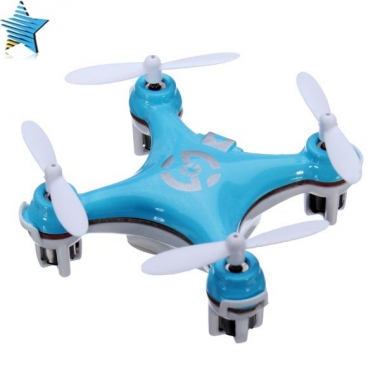
And he did not live long. For two weeks, a four-propeller friend delighted the owner by flying briskly and performing tricks, but he suddenly fell ill. The front left motor stopped working. The pet buzzed plaintively with three propellers and capsized. Surgical treatment was needed. As theporridge was cooked from the ax , the copter was repaired - in this article.
Welcome to kat, quadrocopter guides. Here we learn how to help your little pet.
Let's get acquainted with the patient.
Cheerson CX-10 is a miniature radio-controlled (2.4 GHz band) quadcopter. Its size is 40 x 40 x 22 mm. It is a double-sided printed circuit board with four motors fixed in it and hidden inside a protective plastic case, consisting of upper and lower halves and fastened with four screws. A switch and a charging socket for connecting a USB cord protrude outward (with a built-in primitive charge control [indication] circuit).
We unscrew the four screws, snap off the four latches near the engines (if they break, they are easily glued with dichloroethane) and remove the top cover.
On the printed circuit board we see three microcircuits in the QFN package:

We take out from the lower half of the plastic case, and turn it over. Below are a few details - four transistors, four LEDs (blue - front, orange - rear), power stabilizer, 16 MHz quartz, resistors, capacitors and a LiPo 3.7 V, 100 mAh battery.
It turned out the battery "flowed". The film case is damaged. For the first time I see this:

Judging by the position of the damage, the reason is in the sharp corners of the transistor cases and the power regulator, which the battery probably fought about, not fixed in the case. For prevention, stick the battery to the board or case with double-sided tape. The electrolyte poured several resistors and a transistor marked “004H” (failed to find the datasheet).
To assess the damage, I wash the dishwashing liquid, a toothbrush and water:

From the third time the surface was cleaned. The result of the inspection - several resistors rotted, one transistor has very darkened conclusions and the safety of the conclusions is in question.
The diagnosis is clear. Surgical intervention required. I find out the nominal value of the parts by measuring the resistance of undamaged resistors near other electric motors. Resistance in kOhm is indicated in rounds - it varied somewhat during measurement. The measurement accuracy in Omaha was influenced by old multimeter probes.
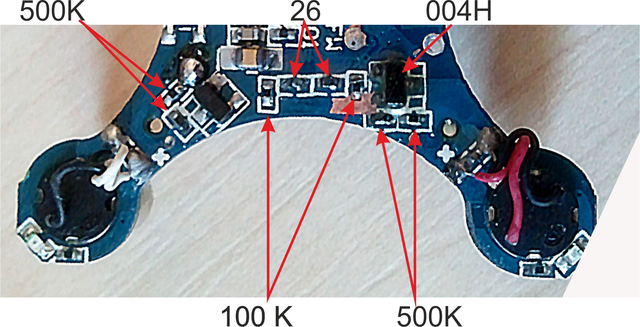
Scheme
The transistor seems to be field-effect, but portrayed as bipolar:

It remained to solve several issues:
Result:
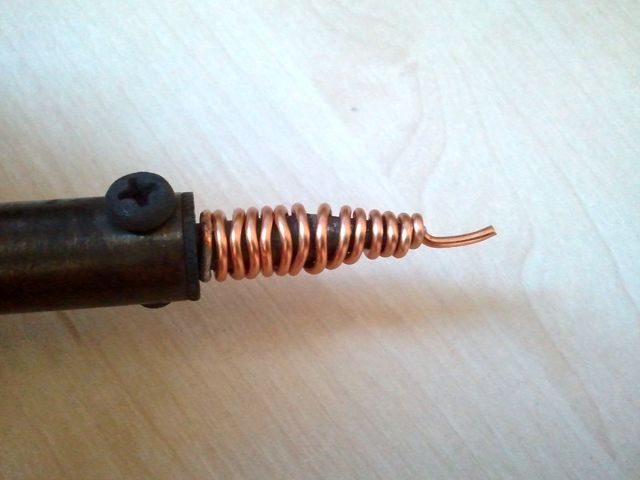
By the end of the operation:
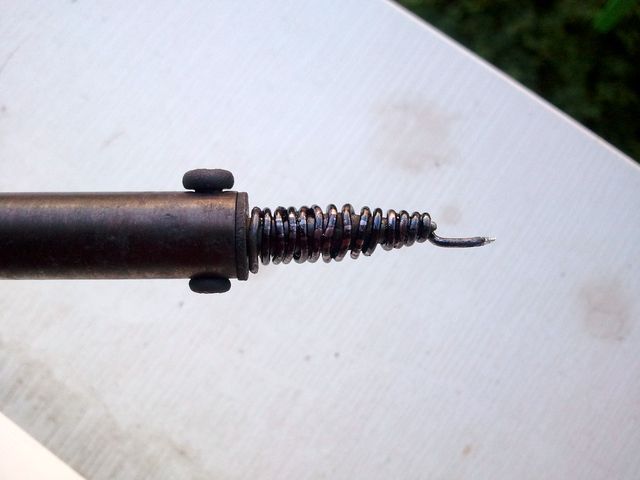
Using Wood's alloy, the damaged resistors and transistor were removed. Pyataks cleaned and tinned.

The removed transistor is examined and with the help of soldering acid its terminals are cleaned. The findings were undamaged and the 004H was returned to its place.

Again, the board is washed with a toothbrush - now from the remnants of the flux. Instead of the battery, the 16850 Li-ion element was soldered. The copter turned on and the fourth electric motor turned on by remote control.
In the photo: without a propeller - a “repaired" engine.
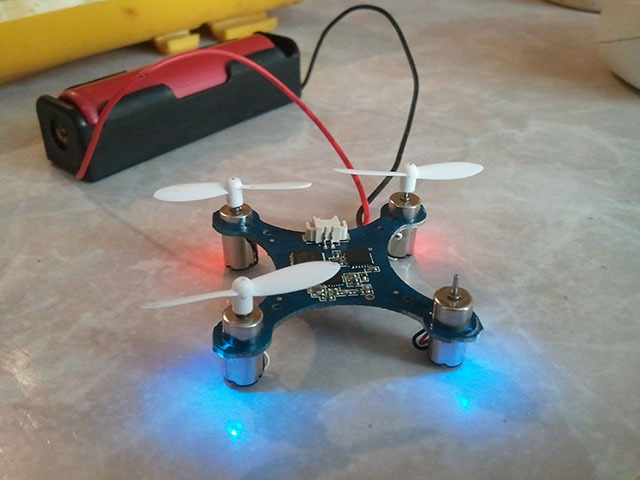
And the final photo is Roboerotic:
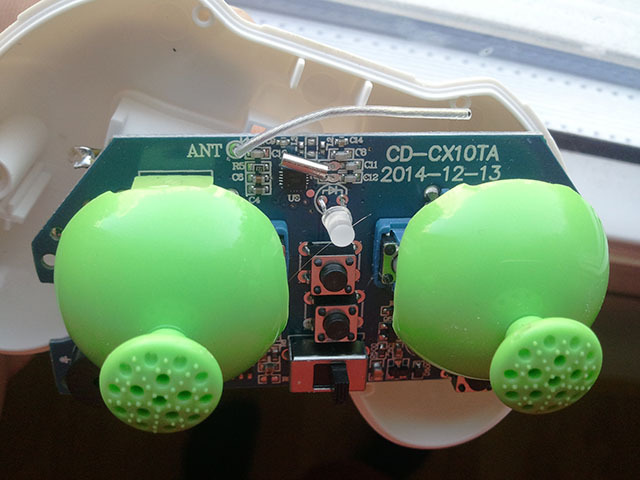
Remote control without housing.

And he did not live long. For two weeks, a four-propeller friend delighted the owner by flying briskly and performing tricks, but he suddenly fell ill. The front left motor stopped working. The pet buzzed plaintively with three propellers and capsized. Surgical treatment was needed. As the
Welcome to kat, quadrocopter guides. Here we learn how to help your little pet.
Let's get acquainted with the patient.
Cheerson CX-10 is a miniature radio-controlled (2.4 GHz band) quadcopter. Its size is 40 x 40 x 22 mm. It is a double-sided printed circuit board with four motors fixed in it and hidden inside a protective plastic case, consisting of upper and lower halves and fastened with four screws. A switch and a charging socket for connecting a USB cord protrude outward (with a built-in primitive charge control [indication] circuit).
We unscrew the four screws, snap off the four latches near the engines (if they break, they are easily glued with dichloroethane) and remove the top cover.
On the printed circuit board we see three microcircuits in the QFN package:

- STM32F031K4 - microcontroller STmicro ARM Cortex-M0 MCU with 16 kbytes Flash, 48 MHz CPU, motor control
- XN297 - 2.4G wireless mouse solution . The remote also uses XN297, but instead of a PCB antenna, a piece of wire (photo at the end of the article). The communication range allows the copter to rise to the roof level of a nine-story building. Further communication was not tested - the copter is not visible.
- lnvensense MPU-6050 - a combined 16-bit accelerometer and gyroscope .
We take out from the lower half of the plastic case, and turn it over. Below are a few details - four transistors, four LEDs (blue - front, orange - rear), power stabilizer, 16 MHz quartz, resistors, capacitors and a LiPo 3.7 V, 100 mAh battery.
It turned out the battery "flowed". The film case is damaged. For the first time I see this:

Judging by the position of the damage, the reason is in the sharp corners of the transistor cases and the power regulator, which the battery probably fought about, not fixed in the case. For prevention, stick the battery to the board or case with double-sided tape. The electrolyte poured several resistors and a transistor marked “004H” (failed to find the datasheet).
To assess the damage, I wash the dishwashing liquid, a toothbrush and water:

From the third time the surface was cleaned. The result of the inspection - several resistors rotted, one transistor has very darkened conclusions and the safety of the conclusions is in question.
The diagnosis is clear. Surgical intervention required. I find out the nominal value of the parts by measuring the resistance of undamaged resistors near other electric motors. Resistance in kOhm is indicated in rounds - it varied somewhat during measurement. The measurement accuracy in Omaha was influenced by old multimeter probes.

Scheme
it turned out

The transistor seems to be field-effect, but portrayed as bipolar:

It remained to solve several issues:
- Purchase resistors in size 0402.
- Buy transistor marked 004H or equivalent.
- Find a soldering iron with which to solder such small details.
Result:
- Offline sellers do not have resistors of this size; they acquired the smallest ones that were - size 0603, 0.6 mm longer.
- The transistor could not be identified by marking, respectively, neither the original nor analogs were purchased. (Maybe it's ST7400 (N-Channel MOSFET) )
- The soldering iron was made of a piece of thick copper wire.

By the end of the operation:

Using Wood's alloy, the damaged resistors and transistor were removed. Pyataks cleaned and tinned.

The removed transistor is examined and with the help of soldering acid its terminals are cleaned. The findings were undamaged and the 004H was returned to its place.

Again, the board is washed with a toothbrush - now from the remnants of the flux. Instead of the battery, the 16850 Li-ion element was soldered. The copter turned on and the fourth electric motor turned on by remote control.
In the photo: without a propeller - a “repaired" engine.

And the final photo is Roboerotic:

Remote control without housing.
